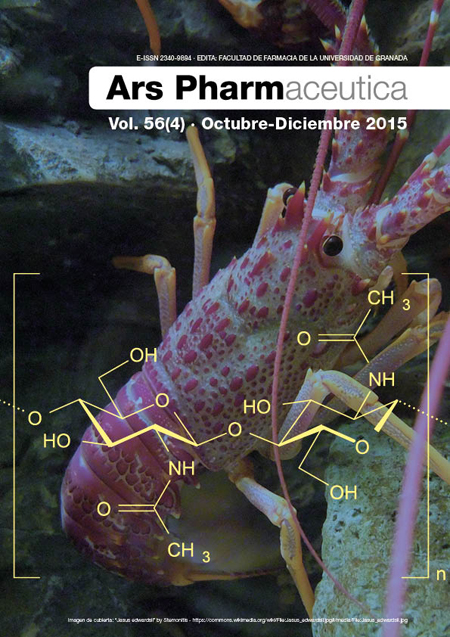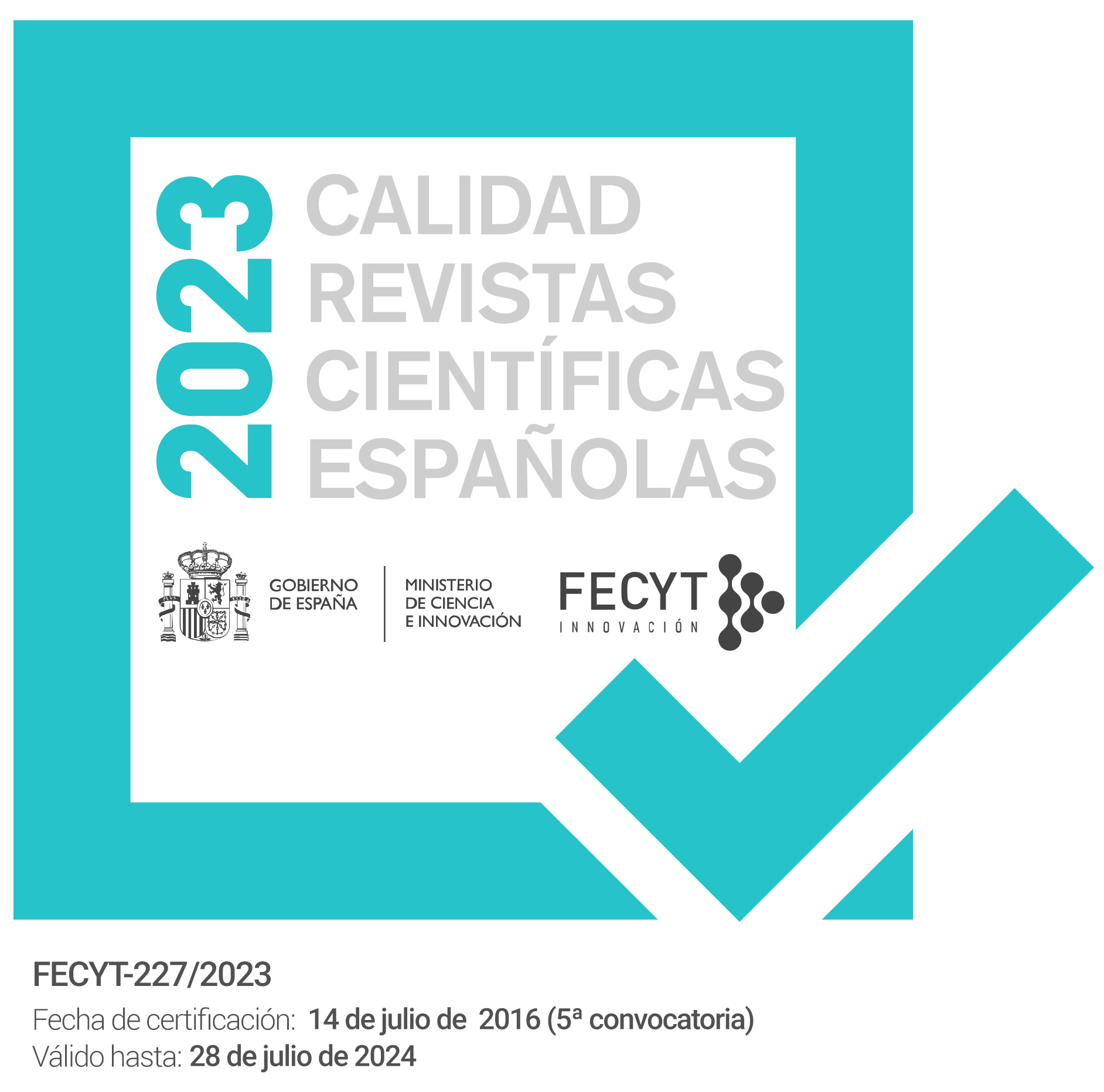Protección cardiovascular con flavonoides. Enigma farmacocinético
DOI:
https://doi.org/10.4321/s2340-98942015000400002Palabras clave:
Quercetina, Hipertensión, Metabolitos plasmáticosResumen
Objetivos. Los flavonoides ejercen efectos beneficiosos en la prevención de las enfermedades cardiovasculares. En esta revisión trataremos de clarificar algunas preguntas fundamentales respecto a la eficacia, mecanismo de acción y biodisponibilidad de uno de los flavonoides dietéticos más abundante, la quercetina.
Métodos. Se utilizó la base de datos de la National Library of Medicine, Washington, DC (MEDLINE: PubMed). Se recopilaron todos los estudios en animales y en humanos disponibles online desde la creación de la base de datos hasta Noviembre de 2015.
Resultados. La quercetina produce un efecto vasodilatador y antihipertensor en modelos animales y en individuos hipertensos. Es eficaz en todos los modelos de hipertensión analizados, independientemente del origen de la hipertensión, del estado del sistema renina-angiotensina, del estrés oxidativo, del óxido nítrico y de otros factores. Paradójicamente, a pesar de ejercer efectos sistémicos biológicamente demostrables, no se encuentra en el plasma tras su administración oral y sus metabolitos circulantes muestran una débil actividad in vitro. La quercetina es extensamente metabolizada en derivados metilados y glucurono- y sulfo-conjugados, que son las formas circulantes en el plasma; y glucurono-, pero no sulfo-conjugados, pueden ser hidrolizados a nivel vascular, produciendo la aglicona matriz que se acumula en los tejidos. La conjugación es un proceso reversible y, al menos con respecto a los efectos vasodilatador y antihipertensivo, el ciclo de conjugación-deconjugación parece ser un requisito absoluto.
Conclusiones. Los glucurono-conjugados transportan la quercetina y su forma metilada, y liberan en los tejidos la aglicona libre, que es el efector final.
Descargas
Citas
Perez-Vizcaino F, Duarte J, Flavonols and cardiovascular disease.
Mol Aspects Med. 2010;31(6):478-494.
Martínez-Flórez S, González-Gallego J, Culebras JM, Tuñón MJ. Flavonoids: properties and anti-oxidizing action. Nutr Hosp. 2002;17(6):271-278.
Hertog MG, Feskens EJ, Hollman PC, Katan MB, Kromhout D.
Dietary antioxidant flavonoids and risk of coronary heart disease:
the Zutphen Elderly Study. Lancet. 1993;342(8878):1007-1011.
Manach C, Scalbert A, Morand C, Remesy C, Jiménez L. Polyphenols: food sources and bioavailability. Am J Clin Nutr. 2004;79(5):727-747.
Geleijnse JM, Launer LJ, Van der Kuip DA, Hofman A, Witteman
JC. Inverse association of tea and flavonoid intakes with incident myocardial infarction: the Rotterdam Study. Am J Clin Nutr. 2002;75(5):880-886.
Hertog MG, Bueno-de-Mesquita HB, Fehily AM, Sweetnam PM, Elwood PC, Kromhout D. Fruit and vegetable consumption and cancer mortality in the Caerphilly Study. Cancer Epidemiol Biomarkers Prev. 1996;5(9):673-677.
Huxley RR, Neil HA. The relation between dietary flavonol intake and coronary heart disease mortality: a meta-analysis of prospective cohort studies. Eur J Clin Nutr. 2003;57(8):904-908.
Miedema MD, Petrone A, Shikany JM, Greenland P, Lewis CE, Pletcher MJ, et al. The Association of Fruit and Vegetable Consumption During Early Adulthood With the Prevalence of Coronary Artery Calcium After 20 Years of Follow-Up: The CARDIA Study. Circulation. 2015. pii: CIRCULATIONAHA. 114.012562.
Duarte J, Perez-Vizcaino F, Utrilla P, Jimenez J, Tamargo J, Zarzuelo A. Vasodilatory effects of flavonoids in rat aortic smooth muscle. Structure-activity relationships. Gen Pharmacol. 1993;24(4):857-862.
Carlstrom J, Symons JD, Wu TC, Bruno RS, Litwin SE, Jalili T. A quercetin supplemented diet does not prevent cardiovascular
complications in spontaneously hypertensive rats. J Nutr. 2007;137(3):628-633.
Machha A, Mustafa MR. Chronic treatment with flavonoids prevents endothelial dysfunction in spontaneously hypertensive rat aorta. J Cardiovasc Pharmacol. 2005;46(1):36-40.
Romero M, Jimenez R, Sanchez M, Lopez-Sepulveda R, Zarzuelo MJ, O’Valle F, et al. Quercetin inhibits vascular superoxide production induced by endothelin-1: Role of NADPH oxidase, uncoupled eNOS and PKC. Atherosclerosis. 2009;202(1):58-67.
Sanchez M, Galisteo M, Vera R, Villar IC, Zarzuelo A, Tamargo
J, et al. Quercetin downregulates NADPH oxidase, increases eNOS activity and prevents endothelial dysfunction in spontaneously
hypertensive rats. J Hypertens. 2006;24(1),75-84.
Duarte J, Jimenez R, O’Valle F, Galisteo M, Perez-Palencia R, Vargas F, et al. Protective effects of the flavonoid quercetin in chronic nitric oxide deficient rats. J Hypertens. 2002;20(9):1843-1854.
Galisteo M, Garcia-Saura MF, Jimenez R, Villar IC, Wangensteen R, Zarzuelo A, et al. Effects of quercetin treatment on vascular function in deoxycorticosterone acetate-salt hypertensive rats. Comparative study with verapamil. Planta Med. 2004;70(4):334-341.
Garcia-Saura MF, Galisteo M, Villar IC, Bermejo A, Zarzuelo A, Vargas F, et al. Effects of chronic quercetin treatment in
experimental renovascular hypertension. Mol Cell Biochem.
;270(1-2):147-155.
Aoi W, Niisato N, Miyazaki H, Marunaka Y. Flavonoid-induced
reduction of ENaC expression in the kidney of Dahl saltsensitive
hypertensive rat. Biochem Biophys Res Commun. 2004;315(4):892-896.
Mackraj I, Govender T, Ramesar S. The antihypertensive effects of quercetin in a salt-sensitive model of hypertension. J Cardiovasc Pharmacol. 2008;51(3):239-245.
Jalili T, Carlstrom J, Kim S, Freeman D, Jin H, Wu TC, et al.
Quercetin-supplemented diets lower blood pressure and attenuate
cardiac hypertrophy in rats with aortic constriction. J Cardiovasc Pharmacol. 2006;47(4):531-541.
Rivera L, Moron R, Sanchez M, Zarzuelo A, Galisteo M. Quercetin ameliorates metabolic syndrome and improves the inflammatory status in obese Zucker rats. Obesity (Silver Spring). 2008;16(9):2081-2087.
Yamamoto Y, Oue E. Antihypertensive effect of quercetin in rats fed with a high-fat high-sucrose diet. Biosci Biotechnol Biochem. 2006;70(4):933-939.
Barker DJ. In utero programming of chronic disease. Clin Sci (Lond). 1998;95(2):115-28.
Buckley AJ, Keseru B, Briody J, Thompson M, Ozanne SE, Thompson CH. Altered body composition and metabolism in the male offspring of high fat-fed rats. Metabolism. 2005;54(4):500-507.
Liang C, Oest ME, Prater MR. Intrauterine exposure to high
saturated fat diet elevates risk of adult-onset chronic diseases in C57BL/6 mice. Birth Defects Res B Dev Reprod Toxicol. 2009;86(5):377-384.
Turnbull F. Effects of different blood-pressure-lowering regimens
on major cardiovascular events: results of prospectively-designed overviews of randomised trials. Lancet. 2003;362(9395):1527-1535.
Edwards RL, Lyon T, Litwin SE, Rabovsky A, Symons JD, Jalili T. Quercetin reduces blood pressure in hypertensive subjects. J Nutr. 2007;137(11):2405-2411.
Egert S, Boesch-Saadatmandi C, Wolffram S, Rimbach G, Muller
MJ. Serum lipid and blood pressure responses to quercetin vary in overweight patients by apolipoprotein E genotype. J Nutr. 2010;140(2):278-284.
Conquer JA, Maiani G, Azzini E, Raguzzini A, Holub BJ.
Supplementation with quercetin markedly increases plasma
quercetin concentration without effect on selected risk factors for heart disease in healthy subjects. J Nutr. 1998;128(3):593-597.
Perez A, Gonzalez-Manzano S, Jimenez R, Perez-Abud R, Haro JM, Osuna A, et al. The flavonoid quercetin induces acute vasodilator effects in healthy volunteers: correlation with beta-glucuronidase activity. Pharmacol Res. 2014;89:11-8.
Manach C, Williamson G, Morand C, Scalbert A, Remesy C.
Bioavailability and bioefficacy of polyphenols in humans. I. Review of 97 bioavailability studies. Am J Clin Nutr. 2005;81(1 Suppl):230S-242S.
Gugler R, Leschik M, Dengler HJ. Disposition of quercetin in man after single oral and intravenous doses. Eur J Clin Pharmacol. 1975;9(2-3):229-234.
Day AJ, Mellon F, Barron D, Sarrazin G, Morgan MR, Williamson G. Human metabolism of dietary flavonoids: identification of plasma metabolites of quercetin. Free Radic Res. 2001;35(6):941-952.
Williamson G, Manach C. Bioavailability and bioefficacy of
polyphenols in humans. II. Review of 93 intervention studies. Am J Clin Nutr. 2005;81(1 Suppl):243S-255S.
Kroon PA, Clifford MN, Crozier A, Day AJ, Donovan JL, Manach C, et al. How should we assess the effects of exposure to dietary polyphenols in vitro? Am J Clin Nutr. 2004;80(1):15-21.
Perez-Vizcaino F, Ibarra M, Cogolludo AL, Duarte J, Zaragoza-
Arnaez F, Moreno L, et al. Endothelium-independent vasodilator
effects of the flavonoid quercetin and its methylated metabolites in rat conductance and resistance arteries. J Pharmacol Exp Ther. 2002;302(1):66-72.
Lodi F, Jimenez R, Moreno L, Kroon PA, Needs PW, Hughes DA, et al. Glucuronidated and sulfated metabolites of the flavonoid quercetin prevent endothelial dysfunction but lack direct vasorelaxant effects in rat aorta. Atherosclerosis. 2009;204(1):34-39.
Bieger J, Cermak R, Blank R, de Boer VC, Hollman PC, Kamphues
J, et al. Tissue distribution of quercetin in pigs after long-term dietary supplementation. J Nutr. 2008;138(8):1417-1420.
O’Leary KA, Day AJ, Needs PW, Sly WS, O’Brien NM, Williamson
G, Flavonoid glucuronides are substrates for human liver beta-glucuronidase. FEBS Lett. 2001;503(1):103-106.
Shimoi K, Saka N, Nozawa R, Sato M, Amano I, Nakayama T, et al. Deglucuronidation of a flavonoid, luteolin monoglucuronide, during inflammation. Drug Metab Dispos. 2001;29(12):1521-1524.
Lee-Hilz YY, Stolaki M, van Berkel WJ, Aarts JM, Rietjens IM.
Activation of EpRE-mediated gene transcription by quercetin
glucuronides depends on their deconjugation. Food Chem Toxicol. 2008;46(6):2128-2134.
Kawai Y, Nishikawa T, Shiba Y, Saito S, Murota K, Shibata N, et al. Macrophage as a target of quercetin glucuronides in human atherosclerotic arteries: implication in the anti-atherosclerotic
mechanism of dietary flavonoids. J Biol Chem. 2008;283(14):9424-9434.
Terao J, Murota K, Kawai Y, Conjugated quercetin glucuronides
as bioactive metabolites and precursors of aglycone in vivo. Food Funct. 2011;2(1):11-17.
Menendez C, Dueñas M, Galindo P, Gonzalez-Manzano S, Jimenez R, Moreno L, et al. Vascular deconjugation of quercetin glucuronide: The flavonoid paradox revealed? Mol Nutr Food Res. 2011;55(12):1780-1790.
Jimenez R, Lopez-Sepulveda R, Romero M, Toral M, Cogolludo A, Perez-Vizcaino F, et al. Quercetin and its metabolites inhibit the membrane NADPH oxidase activity in vascular smooth muscle cells from normotensive and spontaneously hypertensive rats. Food Funct. 2015;6(2):409-414.
Galindo P, Rodriguez-Gómez I, González-Manzano S, Dueñas M, Jiménez R, Menéndez C, et al. Glucuronidated quercetin lowers blood pressure in spontaneously hypertensive rats via deconjugation. PLoS One. 2012;7(3):e32673.
van Duynhoven J, Vaughan EE, Jacobs DM, Kemperman RA, van Velzen EJ, Gross G, et al. Metabolic fate of polyphenols in the human superorganism. Proc Natl Acad Sci U S A. 2011;108(Suppl 1):4531-4538.
Boesch-Saadatmandi C, Niering J, Minihane AM, Wiswedel I,
Gardeman A, Wolffram S. Impact of apolipoprotein E genotype
and dietary quercetin on paraoxonase 1 status in apoE3 and apoE4 transgenic mice. Atherosclerosis. 2010;211(1):110-113.
Bartholome R, Haenen G, Hollman CH, Bast A, Dagnelie PC, Roos D, et al. Deconjugation kinetics of glucuronidated phase II flavonoid metabolites by beta-glucuronidase from neutrophils. Drug Metab Pharmacokinet. 2010;25(4):379-387.
Descargas
Publicado
Cómo citar
Número
Sección
Licencia
Los artículos que se publican en esta revista están sujetos a los siguientes términos en relación a los derechos patrimoniales o de explotación:
- Los autores/as conservarán sus derechos de autor y garantizarán a la revista el derecho de primera publicación de su obra, la cual se distribuirá con una licencia Creative Commons BY-NC-SA 4.0 que permite a terceros reutilizar la obra siempre que se indique su autor, se cite la fuente original y no se haga un uso comercial de la misma.
- Los autores/as podrán adoptar otros acuerdos de licencia no exclusiva de distribución de la versión de la obra publicada (p. ej.: depositarla en un archivo telemático institucional o publicarla en un volumen monográfico) siempre que se indique la fuente original de su publicación.
- Se permite y recomienda a los autores/as difundir su obra a través de Internet (p. ej.: en repositorios institucionales o en su página web) antes y durante el proceso de envío, lo cual puede producir intercambios interesantes y aumentar las citas de la obra publicada. (Véase El efecto del acceso abierto).
























